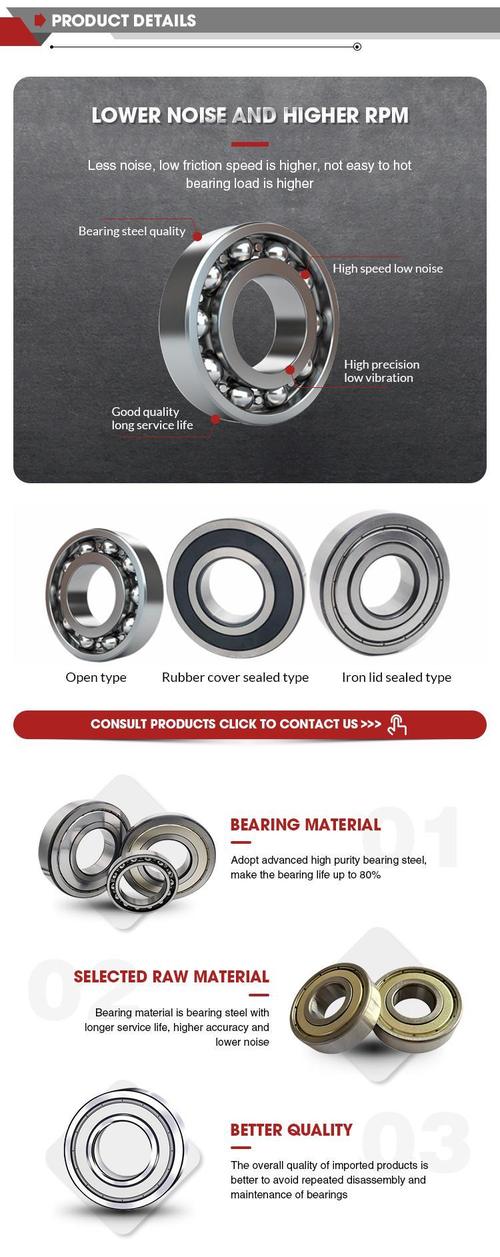Top 5 Essential Facts About Medical Grade Miniature Bearings You Need to Know
Medical grade miniature bearings are specialized components designed for precision medical equipment. These bearings must meet stringent hygiene standards, resist sterilization processes, and maintain accuracy in compact spaces. Their applications range from surgical tools to diagnostic devices, requiring exceptional durability and corrosion resistance.
1、medical equipment miniature bearings2、sterilizable miniature bearings
3、FDA compliant medical bearings
4、high-speed dental tool bearings
5、corrosion resistant surgical bearings
1、medical equipment miniature bearings

Medical equipment miniature bearings are critical components in modern healthcare technology. These precision-engineered parts enable smooth operation in devices like MRI machines, blood analyzers, and robotic surgery systems. Manufacturers typically use 440C stainless steel or ceramic hybrids to achieve both corrosion resistance and biocompatibility. The bearings must withstand repeated sterilization cycles using autoclaves or chemical disinfectants without degrading performance. Strict tolerance levels (ABEC 7 or higher) ensure minimal vibration in sensitive imaging equipment. Recent advancements include FDA-approved lubricants that maintain viscosity across temperature fluctuations. Proper bearing selection reduces equipment downtime and improves patient safety in critical care scenarios.
2、sterilizable miniature bearings
Sterilizable miniature bearings represent a specialized category designed for repeated exposure to harsh cleaning protocols. These components feature sealed designs with medical-grade elastomers that prevent fluid ingress during autoclaving at 134°C. The raceways are often coated with titanium nitride to enhance surface hardness and prevent bacterial adhesion. Manufacturers conduct rigorous testing for steam penetration resistance and thermal expansion compatibility. High-performance variants incorporate ceramic balls that eliminate lubrication requirements while maintaining sterilization integrity. Proper maintenance protocols extend bearing life in surgical handpieces and endoscopic tools, where daily sterilization is mandatory. Recent ISO 13485 updates emphasize traceability in bearing materials to prevent cross-contamination risks.
3、FDA compliant medical bearings
FDA compliant medical bearings meet strict regulatory requirements for biomaterial contact. These components use 316L surgical steel or zirconia ceramics that satisfy USP Class VI standards. Lubricants must be NSF H1 registered for incidental food contact, crucial for dental and ophthalmic instruments. Manufacturers provide full material disclosure certificates and biocompatibility test reports. The production process occurs in cleanrooms meeting ISO Class 7 standards to prevent particulate contamination. Specialized finishes like electropolishing reduce surface roughness below 0.2μm Ra, minimizing bacterial colonization. Recent developments include MRI-safe bearings with non-magnetic alloys for compatibility with advanced imaging systems.
4、high-speed dental tool bearings
High-speed dental tool bearings operate at 400,000 RPM while maintaining precision under lateral loads. These miniature components use hybrid ceramic designs with PEEK retainers to reduce heat generation. Advanced cooling channels in the bearing housing prevent thermal expansion during prolonged procedures. Noise reduction technologies ensure patient comfort during drilling operations. The bearings feature quick-disconnect designs for efficient sterilization between patients. Manufacturers conduct accelerated life testing simulating 5 years of clinical use. Recent models incorporate smart sensors that monitor bearing wear and alert technicians about required maintenance.
5、corrosion resistant surgical bearings
Corrosion resistant surgical bearings utilize martensitic stainless steels with passivation treatments to withstand bodily fluids and cleaning agents. These components demonstrate exceptional pitting resistance equivalent to PREN ≥40. Specialized coatings like DLC (Diamond-Like Carbon) enhance surface durability in orthopedic power tools. The bearings incorporate labyrinth seals that exclude contaminants while allowing steam penetration during sterilization. Manufacturers perform salt spray testing exceeding 500 hours to validate corrosion protection. High-end versions use nitrogen-alloyed steels for improved stress corrosion cracking resistance in bone saw applications.
Understanding medical grade miniature bearings requires examining five critical aspects: sterilization compatibility, regulatory compliance, material science, precision engineering, and application-specific designs. From dental turbines to robotic surgery arms, these components directly impact equipment reliability and patient outcomes. This comprehensive guide explores material selections, maintenance protocols, and technological innovations that define modern medical bearing solutions. Discover how proper bearing specification enhances device performance while meeting stringent healthcare regulations.
This article has explored essential considerations for medical grade miniature bearings, covering sterilization requirements, material certifications, and high-performance applications. Proper bearing selection ensures compliance with medical standards while optimizing equipment lifespan. As healthcare technology advances, these precision components will continue playing a vital role in diagnostic accuracy and surgical outcomes.




 13869596835
13869596835